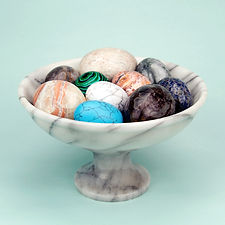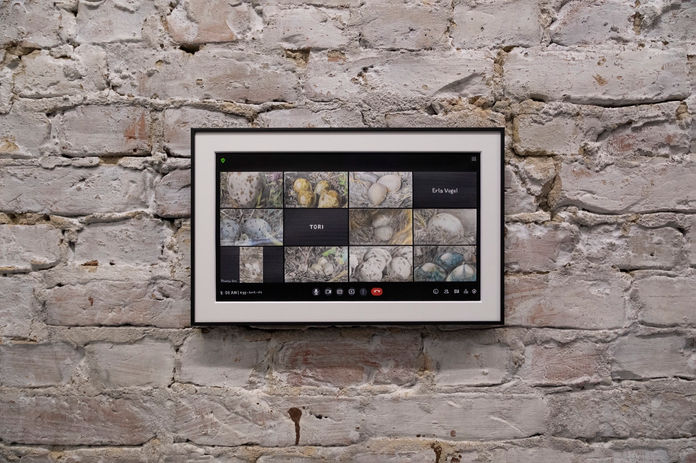Oology and Others
After the Industrial Revolution in eighteenth-century Britain, urbanization and the environmental pollution that followed stirred a longing and nostalgia for the natural countryside. Collecting bird eggs and other natural objects bestowed on their owners a romantic sense of reconnecting with nature. As collecting scaled up, a field centered on bird eggs and nests was established as oology. Even though oology was occasionally examined within the framework of ornithology, it long lacked clear scientific value and was largely regarded by the public as a pleasing "natural trophy." As the community of collectors expanded, bird eggs and nests were further regarded as collectible items of considerable transactional and social value.
By the 19th century, under the sway of national honor, what had begun as a private passion for natural history collecting became a priority for public museums. Vast quantities of natural specimens were gathered into museums and private collections. From the mid‑twentieth century onward, wildlife protection laws gradually prohibited private ownership of oological collections, forcing many private holdings into museums. On the one hand, these large collections indirectly enabled unexpected interdisciplinary research in later years; on the other, they pushed oology out of public view, turning it into an almost forgotten discipline and category of collecting.
From rustic pastime to scientific collection, oology's ambiguity and difficulty of definition have scattered its discursive possibilities. The perfection yet fragility of the egg and the ordinariness yet grandeur of the nest are inherently compelling. But the desire that drives it all ultimately comes down to something simple: humans want to collect/possess beautiful things from nature, plain and unadorned.
Oology and Others Matters does not aim to present an actual oological collection. It is closer to an inquiry into a once fevered "collecting event." What fascinates me about oology is not only the eggs and nests themselves, but also their mix of seriousness and caprice, so puzzling it can be laugh-inducing. As a field that was never quite "serious" enough academically, it sits in an overlapping state of being forgotten and being reborn, and that gives it a unique allure. Oology is held in suspension between aesthetics and science, sentiment and reason. It can touch down in the everyday, in history, folklore, form, and taste, while also scaling up to questions of reproduction, ecology, phenology, structure, and materials. If the shell and the nest are physical vessels, then oology is a vessel for consciousness and sentiment, encompassing/surrounding other matters, both near and far.
(This project developed during a residency at Delfina Foundation (UK), work stipend offered by Ministry of Culture (TW) and the Department of Cultural Affairs, Taipei City (TW); SOMA exhibition supported by Senate Department for Culture and Europe (DE) and Taishin Bank Foundation for Arts and Culture (TW); NCCU Art Center exhibition supported by Tianmei Art Foundation (TW)
An Eggy Video Meeting
Pencil, color pencil, marker pen, gel pen, acrylic ink, paper
19.75×34.95 cm, 20.6×33.2 cm, 18.2×33cm, 19.7×30.3 cm, 21.9×34cm, 19.6×31cm, 17.9×31.8cm, 22.8×36.6cm
2022-2025
During an eggy video meeting, my concentration often wanders to the space behind the participants. The blurry background renders the boundary of proper manners fuzzy. When peeking into a stranger's household through a screen, I feel a bit awkward, but not even sorry.
These video sessions stream from the nests of birds, and without a human host. We don’t know who announced it? What’s the agenda? Or who’s speaking now? The non-human embryo (egg) carries a human name, as many birds share their name with people. Some are originally bird's names but are given to people because of the lovable qualities of the birds. Or some were named after their discoverer, to honor their achievement involuntarily.
A home or a nest represents the small nature of one individual, but our instinct continues to drive us to explore the greater nature external. Occasionally, we collect objects from nature. This is not a thing to brag about, but I see it as a reminder of how unexceptional we are. To explore also means to disrupt. Among all the non-human creatures, a bird's home – the nest and the egg – is remarkably exquisite and has a variety that has enchanted many of us. This is true even though in people's etiquette, one’s living and breeding place should be screened for privacy. The nests and the eggs of birds, still exposed from the discreet nature, have become collectible specimens or images, public in the hands of humans, without the birds being asked.
*****
eggy
/ˈɛɡi/
(UK, slang) Slightly annoyed.
Domestic Dominion Degradation
UV resin, UV lacquer, UV light, carpet
Installation size
2022-2025
The abstract object in the darkened space is a 3D-printed sculpture that fuses birds, eggs, and nests into simplified spirals and arcs. As the viewing angle shifts, it transforms into various forms, becoming a collective entity without distinction between inside and outside, bearer and borne. Under UV illumination, the sculpture emits a pale blue-violet fluorescence, echoing birds’ ability to perceive ultraviolet light to recognize their surroundings and eggs.
UV-curable resin, a material used in 3D printing, solidifies under ultraviolet light but gradually degrades or even decomposes with excessive exposure. This dual nature between the material and UV light forms the core message of the installation—a meditation on the threshold between construction and disintegration. The interpretive entry point is a carpet pattern referencing Jurassic Park/World. The Jurassic series has consistently revolved around humanity’s attempts to control nature, which often resists such control and leads to systemic catastrophe. This work was first created in 2022, coinciding with the release of Jurassic World Dominion, originally scheduled for 2021 but delayed due to the COVID-19 pandemic—rendering the title “Dominion” all the more ironic.
%20SS.jpg)
%20SS.jpg)
%20SS.jpg)
%20(54X81cm%20300dpi)%20SS.jpg)
Clutch Illuminated (Amazon)
Inkjet print
63×42 cm, three pieces; 54×81 cm, one piece
2022
In 2022, I had the opportunity to participate in a ten-day residency in Manaus, located in the Amazon region. I brought along a 3D-printed sculpture. One evening, a visiting entomologist took us on a nighttime walk, using UV light to reveal insects that were otherwise invisible. On the final night, I brought my sculpture into the rainforest and took these photographs.
Uterus Is a Kiln, Egg Is Fired
Found Wagner & Apel ceramic, Egg tempera, HD videos, white porcelain, resin, stone eggs, UV print on calcium silicate board, papercraft
Installation Size
2022-2025
From a topographical perspective, each moulded ceramic figurine—closed yet hollow—resembles an egg in structure. Could an egg, then, be understood as a ceramic object fired within the body of a bird?
The interest in the hoopoe traces back to research on national animals during the making of No Country for Canine. In 2008, the hoopoe was voted the national bird of Israel. It is a species marked by ambivalence: admired for its striking appearance and presence in myths across East and West, yet also known for nesting in cemeteries and smearing its nest with feces and foul-smelling secretions as a defensive strategy.
I found a Wagner & Apel made hoopoe figurine at a flea market and scanned it into a 3D file. Its texture map was repainted in tempera, symbolically inverting inside and outside through material language. The black areas were autofilled repeatedly using software, with each iteration producing subtle variations. When played in sequence, the resulting images evoke a sense of fluidity. This repainted texture was then applied to a paper model, made available for viewers to take. A second trajectory involved enlarging the model to near life-size, generating eight variations through iterative resolution shifts. These forms illustrate a transition from bird-like to egg-like shapes, with a nod to Brancusi’s modernist sculpture. The search for a morphological overlap between bird and egg also reflects a speculative inquiry in oology into the relationship between the mother bird and the shape of her egg. The final models were produced in both transparent resin and white porcelain, embodying a duality of presence and absence, interior and exterior.

Oology and Others
Single channel 4K
14 minutes 25 seconds
2025
This video weaves together several journeys related to oology, with its central thread being a 2022 walk along the RSPB Bempton Cliffs—once a key site during the height of oology fever, now a protected nature reserve. Following the clue that dinosaurs were the first egg-laying animals, the opening sequence includes footage from Crystal Palace Dinosaurs, a park on the outskirts of London featuring the earliest dinosaur sculptures in human history. Due to gaps in scientific knowledge at the time, many of these figures are anatomically inaccurate. Their presence serves as a metaphor for the absurdity embedded in oology and the blurred space between amateur fascination and serious science.
The middle section of the video moves to Scarborough Museum and Art Gallery, and the Natural History Museum at Tring. In Scarborough, a curator showed me historical egg-collecting tools; in Tring, I encountered several Formosan bird nest specimens marked with taxonomic errors. These nests open a small branch of inquiry into Taiwan’s historical entanglements and the precursors to the Anthropocene. Beneath these loops and detours lies a deeper attempt to reflect on the contradictions between humans and nature, between desire and collection.
(Online link will be available in December.)

%20(64x96CM%20300DPI)%20SS.jpg)
%20(68X45_3cm%20300dpi)%20SS.jpg)
Balance and Seasoning (Bethanien Berlin)
Inkjet print | 64×96cm | 2017
Balance and Seasoning (Delfina London)
Inkjet print | 68×45.3cm | 2022
Era
Inkjet print | 32×32cm | 2016
I have a tray of stone eggs collected over time—gathered simply because they were beautiful and amusing. At first, I imagined collecting a stone egg from each place I travelled. But I soon realized that these particularly striking stones were no longer tied to local. Most are modern products of global commerce: extracted across borders, mass-produced, and redistributed.
Later, I brought them to a residency. Such institutions often host artists from around the world, and over time, their kitchens accumulate an eclectic mix of spices from distant places. I carefully arranged the stone eggs in a corner of the kitchen, matching them by color, letting them blend in like a quiet ritual among the seasonings. Both cooking and egg-balancing rely on balance—and both flavor and stone are part of the everyday circulation of today’s world.






















































